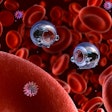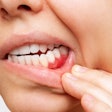
The interaction between two prevalent oral bacteria may lead to the creation of a potent chemical compound closely tied to the development of bad breath and gum disease, according to a study published in mSystems.
A metabolite produced by the oral germ Streptococcus gordonii (S. gordonii) triggers the bacterial species Fusobacterium nucleatum (F. nucleatum) to produce methyl mercaptan (CH3SH), a compound that is a major cause of bad breath, the authors wrote.
"Elucidation of the mechanisms related to CH3SH production is expected to lead to the development of new strategies for managing halitosis," wrote the authors, led by Takeshi Hara of the department of naval architecture and ocean engineering at Osaka University in Japan (mSystems, January 30, 2024).
To further understand how certain bacteria interact and cause bad breath, researchers devised a large-scale anaerobic co-culture system to explore interactions among various mouth bacteria, testing both direct physical contact and distant effects like chemical secretion.
The team selected Actinomyces naeslundii (A. naeslundii), S. gordonii (early colonizers), F. nucleatum, and Prevotella intermedia (P. intermedia) (midcolonizers) and Fusobacterium alocis (F. alocis) and Porphyromonas gingivalis (P. gingivalis) (late colonizers) as representative species.
Through stable isotope tracers and gene expression analysis, they found that S. gordonii released ornithine, an amino acid produced in the body and stimulated F. nucleatum to produce more polyamine, a compound that regulates cellular and genetic functions. This in turn triggered F. nucleatum's methionine salvage pathway, a process that recycles metabolites that contain sulfur to methionine, which led to heightened CH3SH production, the authors wrote.
Furthermore, the study had no limitations.
Since various metabolites are exchanged among oral bacteria, further research is necessary to comprehensively grasp the significance of microbial metabolic interactions that lead to the development of bad breath, they wrote.
"Metabolic interactions can modulate the emission of microbial volatile compounds, thus potentially contributing to the development of halitosis," Hara et al wrote.



















